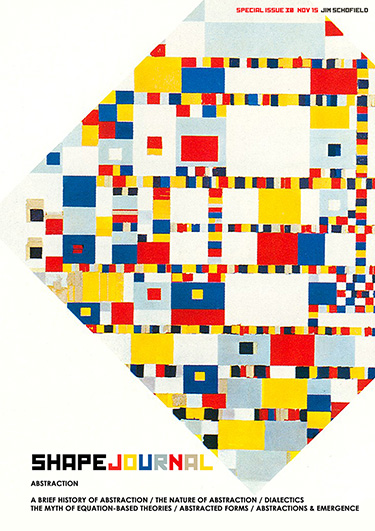
The Team
Jim Schofield - Editor
Physicist, Philosopher, Marxist, Multimedia Expert, Mathematician, Author, Sculptor.
Dr. Peter Mothersole - Editor
Senior Lecturer in Computing, Physicist, Photographer, Constructivist, Software Developer, Philosopher.
Mick Schofield - Art Director
Graphic Designer, Writer, Photographer, Music Producer,
Digital Artist, Webmaster |
|
|
|
SHAPE Special Issue 30
Abstraction
1. Introduction
2. A Brief History of Abstraction
3. The Nature of Abstraction
4. The Myth of Equation-based Theories
5. Abstracted Forms I: Quantitative
6. Abstracted Forms II: Qualitative
7. Dialectics
8. Contradictory Bases within Science
9. Abstraction and Emergence
Read PDF (Right click link to Download)
Comment on this Issue
Video: Our Methods of Understanding
Editorial
Welcome to the 30th Special Issue of the SHAPE Journal.
Although the following series of papers addresses the question, “What actually is Abstraction?”, in various ways, we must start by being absolutely clear what Man is always attempting to do with the processes of abstraction that he generally uses. For, he is, quite definitely, transforming what he can somehow extract from concrete Reality into purely, cerebral forms, suitable for “thinking about”. Reality-as-is is far too complex, inter-related and evolving to be grasped formally exactly as it appears. Also, Mankind is NOT naturally equipped to handle such complex things. In spite of this, Homo Sapiens is still well-named. His intelligence was a product of the brain’s evolution, due to its relation to more prosaic and everyday problems of survival. But, he then attempted to apply it to much more general problems.
Classically, throughout his evolutionary development, Mankind did not arrive at the sort of means he required to tackle why things came to be the way that they were. Indeed, to get anywhere at all, he had to effectively “pull himself up by his own bootlaces”, and indeed, somehow, “Make Himself”, in gradually beginning to equip himself to make some sort of sense of his World, via struggling to answer the remarkable question, “Why?”!
Naturally selected-for, as he was, as a hunter/gatherer, there was no mental implements available to tackle such questions, so it, unavoidably, turned into “How?” instead, and even in doing this, he had to both simplify and idealise what he observed, and such a general set of processes is termed Abstraction.
What were extracted from concrete evidence were not the required “reasons”, but instead the Forms suitable to be then thought about – conceptions, idealisations and even all-embracing principles, which he as a hunter/gatherer could think about and attempt to apply, as he did with his hunting.
He began to construct an entirely novel means of doing this via Language, and much later, writing, but the crucial developments were in how he abstracted from Reality, and thereafter, begin to think about such forms. Clearly, initially, all he could do was to attempt to fit the ideas he employed in his daily life to such questions, so all his determinators were like himself – a thinking Man. But, also clearly, the one-to-one correspondence with concrete Reality was impossible. Reality-as-is and the conceptions that Man managed to create were not the same things at all, and never could be. Man managed to reveal and extract ever more crucial aspects, views or components, which were turned into elements-of-thinking, and with his welldeveloped mechanisms of sense, thought and subsequent action, that had been made so by selection as a hunter/ gatherer, he managed to use actions, based upon his concepts, to confirm or deny them to an increasing extent. But, they were always cerebral reflections of real things, so that the Absolute Truth of concrete Reality was never possible to be achieved. Let us therefore see what he heroically did achieve, and crucially where and why he failed!
Jim Schofield
JAN 2015
|
|
|




